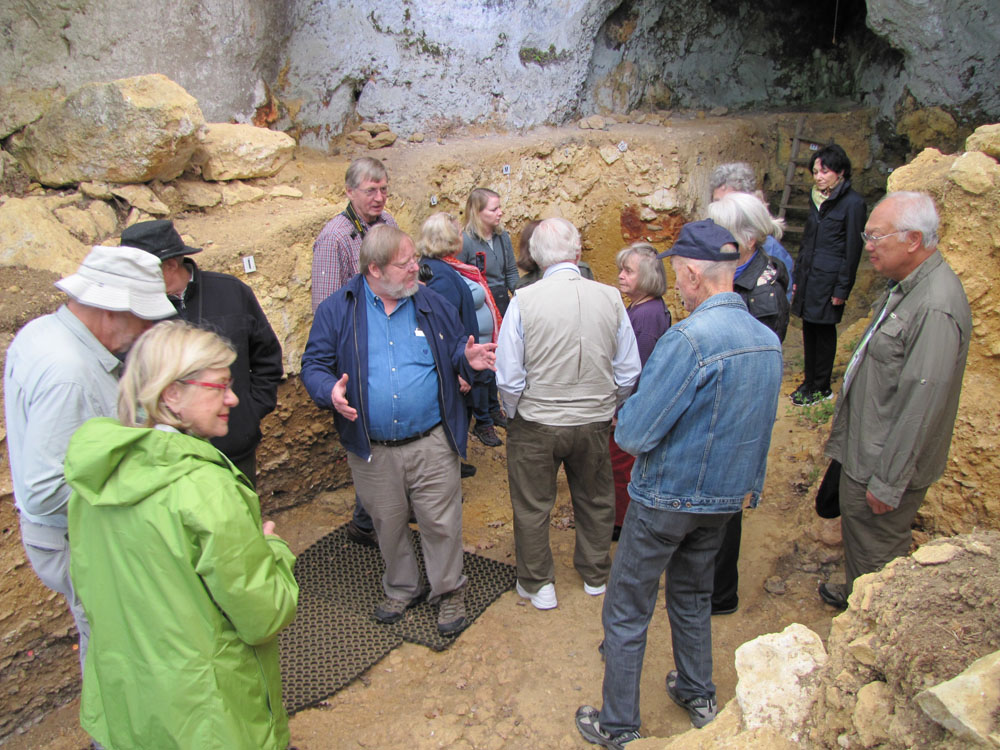Director's Diary
By Sharal Camisa, Executive Director
The Leakey Foundation’s Fellows Tour began in Santander, Spain, one of the richest regions in the world for archeological sites from the Upper Paleolithic period, and continued with a visit to Southern Spain and the rock of Gibraltar.
Our home base for this two-day extension was Malaga. Malaga’s history spans about 2,800 years, making it one of the oldest cities in the world…a perfect place to immerse ourselves in the varied stories of our ancestors. Its rich history is on display with monuments and remains from the Phoenician, Roman, Arabic and Christian eras. Our hotel was within steps of the walls of the Phoenician City and a Roman theater dating from the 1st century BC; the hotel was a carriage ride away from the Castle of Gibralfaro built during the 11th century; and the hotel stood in the shadow of the Malaga Cathedral built between 1528 and 1782.
[FUN FACT: The original plan for the Malaga Cathedral included two bell towers, but only one tower was erected due to the reallocation of funds. Where were the funds spent instead? The money was donated to help the cause for American Independence. A bronze plaque is affixed to an external wall of the Cathedral, presented in 1957 by the National Society for the Sons of the American Revolution. The plaque reads, “We hereby wish to express our sincere and deep appreciation for the generosity of the people of Malaga…who in the year 1780 contributed 400,000 reales to his Majesty King Carlos III for aid to the American Colonies in their war with Great Britain and for support of General Bernardo de Galvez Governor of Louisiana. As a result of their generosity they abandoned the construction of the second bell tower for this cathedral. We will never forget your offering to our country.” Today, the Malaga Cathedral is affectionately known as, La Manquita, loosely translated as “one armed woman”.]
An hour’s journey from Malaga, overlooking the countryside is the megalithic complex of theDolmens of Antequera. We were greeted by the Director of Research at the Dolmens, Dr. Leonardo Garcia Sanjuan and the newly elected President of the Royal Academy of Antiquera, Bartolome Ruiz Gonzalez. These megaliths are prehistoric forms of architecture dating from the Neolithic, about 6,500 years ago. We began our visit with a viewing of an animated-short film on the variety of techniques used by the builders to create these stone chambers. Imagining the strength needed to move the massive slabs of stone and the precision needed to place those stones, inspired appreciation for the value these people placed on these spaces of ritual.
The Menga Dolmen is considered to be the largest such structure in Europe, with a narrow passageway opening to an oval shaped chamber at the opposite end of the entrance. The entrance to Menga is facing the north where the sun would rise during the summer solstice. This orientation is unusual, although Dr. Garcia Sanjuan explained that it is aligned with an enormous crag of limestone rising 2,880ft called La Peña de los Enamorados. He hypothesizes that this remarkable limestone formation (with its shape resembling a sleeping woman) was a powerful symbol with deep ritual significance to the people of that time. One piece of evidence to support that idea is the schematic-style prehistoric paintings in a cave on the north face of La Peña de los Enamorados.
The walls of Menga were constructed using 24 massive upright stones, with three stone pillars holding up the five stones acting as the roof. Once covered by dirt, Menga’s dome is 164ft. in diameter. I truly understood the extraordinary construction of this monument when Dr. Garcia Sanjuan explained that geologists from the local university came to Menga to determine the weight of the 33 slabs of rock used to construct Menga. I greatly appreciated the (fun) way the weight was explained… “Imagine two jumbo jets stacked one on top of the other, both filled with people and petrol…that is equivalent to the weight of the stones.” I love science!
Out time in Antiquera also included exploring the Tholos of El Romeral and then a truly unique culinary experience at a nearby restaurant called Arte de Cozina. The chef creates dishes using traditional and ancestral recipes from the region. My favorite dish was a trio of cold soups: one red, one white, one green.
Our last day of the tour took us to the rock of Gibraltar for an excursion by boat to understand the geology of the rock and see the locations of the famous Gorham’s Cave Complex- including Vanguard, Hyena, Bennetts and Gorham’s Caves.
Our guides for this exciting adventure were native Gibraltarians Dr. Clive Finlayson and Dr. Geraldine Finlayson. Clive Finlayson is a paleontologist and the Director of the Gibraltar Museum. For over 30 years, he has been known the world-over for his research on Neanderthals as well as his vast experience studying the natural and cultural aspects of Gibraltar. He has researched and assisted in a number of international television documentaries on ecology and on human evolution for the BBC, National Geographic Explorer Series, and Discovery Channel; he has authored or co-authored books and has published in science and history journals.
Geraldine Finlayson is Deputy Head of Heritage, as well as Director of the Institute for Gibraltarian Studies and Chief Laboratory Scientist of the Gibraltar Museum. She co-directs the Underwater Research Unit (URU) that is currently surveying the seabed and caves for the Gibraltar Caves Project. As Director of the Institute for Gibraltarian Studies, she is responsible for the research into the intangible heritage of Gibraltar, including linguistic studies and oral histories.
Dr. Geraldine Finlayson has said that Gibraltar was once “a Mediterranean Serengeti” where “deer, wild horse and cattle grazed on the savannahs and were stalked by a strange mix of predators that included spotted hyenas, leopards, brown bears, wolves and lynxes. This was truly a bit of Africa in Europe.”
Evidence has shown that Neanderthals were not only exploiting their marine habitat, but in a captivating paper in PLOS One entitled, “Birds of a Feather: Neanderthal Exploitation of Raptors and Corvids”, Dr. Finlayson et. al argue that Neanderthals had the cognitive ability to think symbolically and create ornamentation, “by cutting the feathers and inner bones from the birds of prey they captured, leaving them with the outer shell, and using them as ornaments as has been the case in other cultures across the world.”
Some of Dr. Clive Finlayson’s work in recent years has been to add the Gorham Cave Complex to the UNESCO World Heritage List. Here is a short excerpt from his 2012 proposal:
“The attributes that give the site its Outstanding Universal Value are: (a) Gorham’s Cave is the last known site of the Neanderthals on the planet and records the arrival of the earliest modern humans; (b) Gorham’s Cave has an unrivalled archeological and paleontological sequence; (c) Gorham’s and Vanguard Caves provide unique high resolution evidence of Neanderthals behavior; (d) Gorham’s and Vanguard Caves provide high resolution evidence of climate change between 55 and 10 thousand years ago; (e) The Caves and cliffs within the site retain all the features that made it a favoured habitat for the Neanderthals. The landscape uniquely memorializes an extinct people and their culture”
Before heading back to shore, the captain ferried our boat to show us where the coast might have been during the time of the Neanderthals. Today, the depth of the Strait of Gibraltar ranges from 980-2,950 feet, but when the Neanderthals were living on the landscape, the sea level was about 350 feet lower! This means that our ancestors may have once occupied caves that are now submerged. Ongoing research by the Underwater Research Unit will surely offer a more comprehensive picture of life on and near Gibraltar.
As we entered the marina at the end of our day together, I had the chance to ask Dr. Clive Finlayson one more question. “If you could find the definitive answer to one question about human origins, what would it be?” Without missing a beat, he smiled and said, “Did Neanderthals have art?” Time will only tell, but I’m confident that the Finlayson’s are on the trail to finding the answer.
If you would like to be part of the next Leakey Foundation Fellows Tour in 2015, please contact Sharal Camisa.

Camilla Smith with the “face” of La Pena de los Enamorados in the background
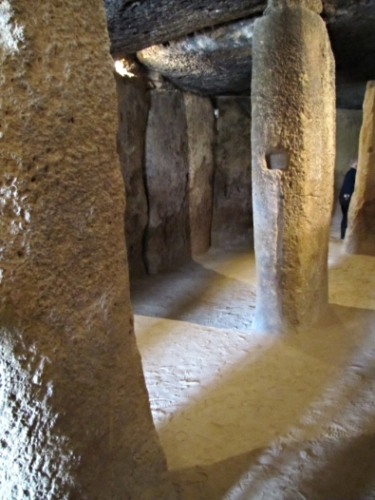
Inside the Menga Dolman.
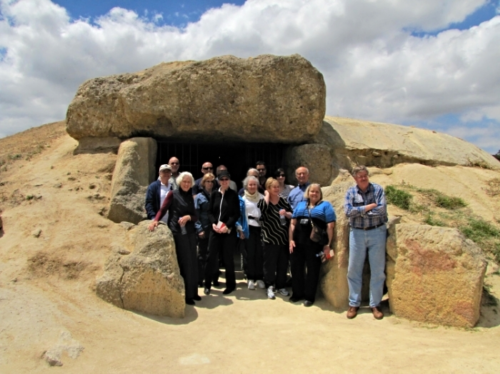
The entrance to the Menga Dolman.
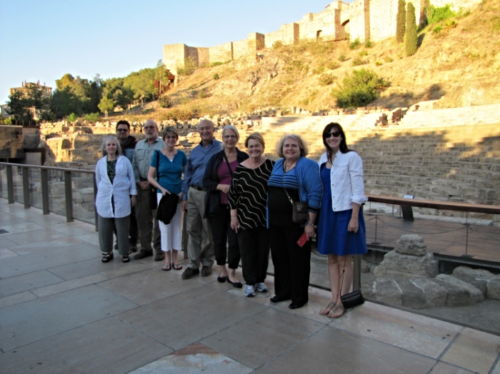
In front of the Roman Theater in Malaga.
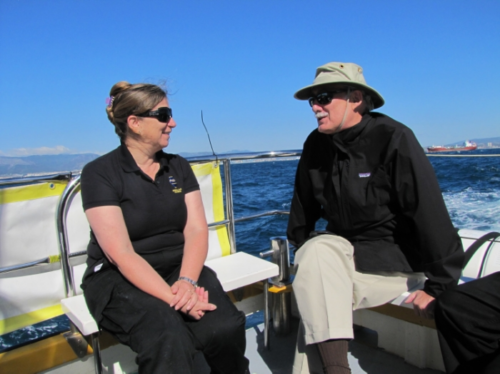
Geraldine Finlayson and Don Dana.
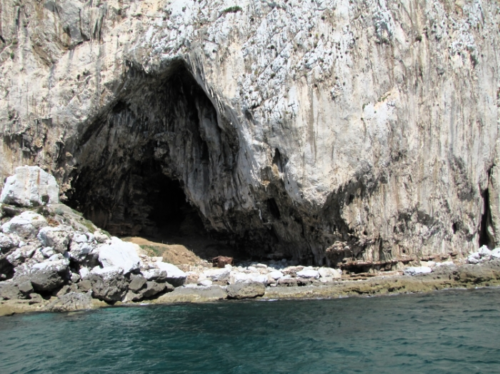
Gorham’s Cave.
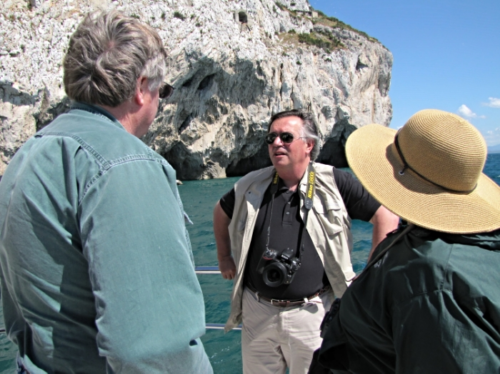
Clive Finlayson and Leakey Travelers.
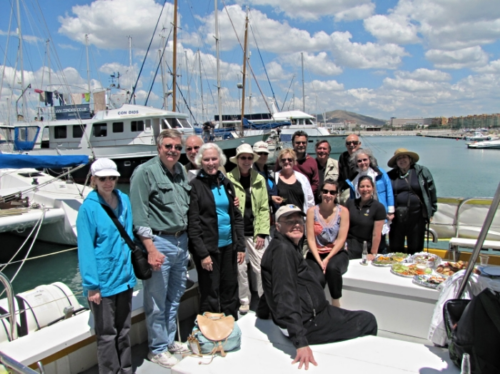
The “Crew”.
